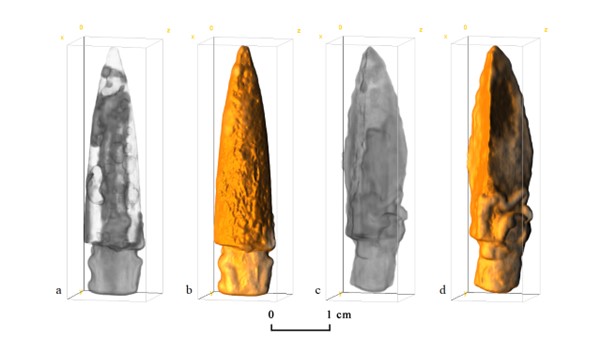Excavated from a Western Han Tomb near the site of Han Chang'an dating back to 202 BCE, these copper alloy and iron arrowheads made the precarious journey from China to the UK for analysis at ISIS. Neutron techniques were selected to investigate these irreplaceable ancient artifacts because they are non-destructive and non-invasive, allowing researchers to glean valuable insights into the materials and processes used in their formation, without the risk of damage.
 Arrowheads made of copper alloys were developed during the Bronze Age, between the Shang and the Warring States periods. Copper-alloy-iron arrowheads were a later innovation from the Iron Age, between the Qin and Han dynasties around 2000 years ago. While previous studies had analysed copper-alloy-iron arrowheads, the question of how exactly the copper and iron portions were joined together remained unanswered.
Arrowheads made of copper alloys were developed during the Bronze Age, between the Shang and the Warring States periods. Copper-alloy-iron arrowheads were a later innovation from the Iron Age, between the Qin and Han dynasties around 2000 years ago. While previous studies had analysed copper-alloy-iron arrowheads, the question of how exactly the copper and iron portions were joined together remained unanswered.
From an archaeological project nthe Han Chang'an city site, managed by the Xi'an Academy of Conservation and Archaeology, over seventy arrowheads were painstakingly excavated. Other artifacts found in the Tomb included ceramic pots, animal figurines, iron swords, and several bronze coins inscribed with Wuzhu. Two copper-alloy-iron arrowheads were selected for analysis based on their preservation status, and shape.
The team settled on three primary neutron techniques: Neutron resonance capture analysis, neutron imaging and neutron tomography. Combining these three techniques allowed the researchers to learn about the elemental composition of the arrowheads, create detailed 3D models, and learn about techniques used in their casting processes. Through these analyses, researchers were able to determine the relative abundances of tin and lead in the two arrowheads. They discovered that in the manufacture of the arrowheads, the iron tangs were most probably cast first, and then inserted into the arrowhead mould and molten bronze was poured in, thereby causing the two metals to fuse together. Researchers also discovered the nature of corrosion products using these techniques, consisting of cuprite, hematite, goethite and others, these insights are a valuable addition to our knowledge of ancient Chinese arrowhead manufacturing processes, and their durability.
Being the first of its kind study into Chinese cultural heritage artefacts using neutron techniques, this pioneering research again highlights the wide range of neutron science applications.
Read the full paper: Revealing the manufacturing and corrosion characteristics of Chinese archaeological metal arrows by non-destructive neutron techniques
